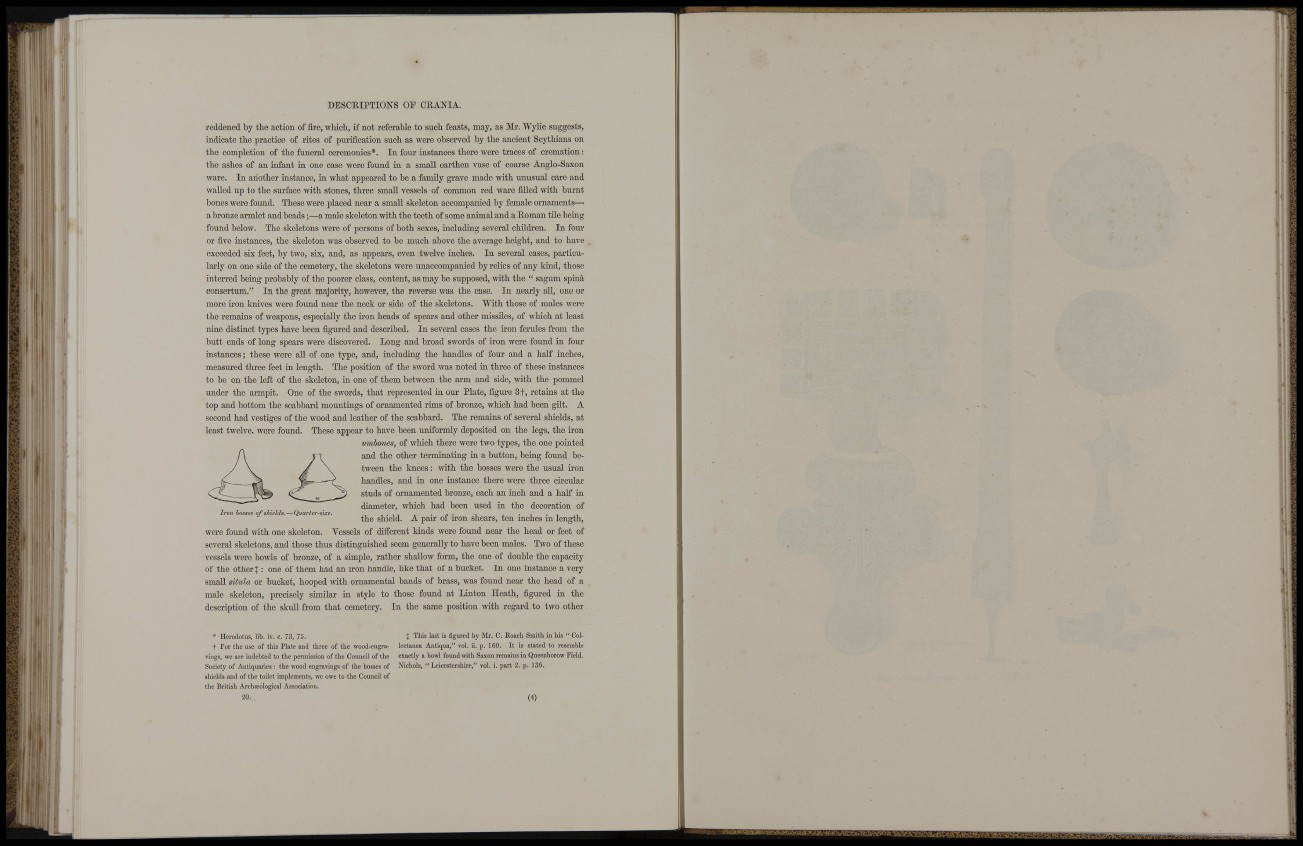
•.¡If i:
reddened by the action of Are, whieli, if not referable to suoli feasts, may, as Mi-. Wylie suggests,
indicate the practice of rites of purification such as were observed by the ancient Scythians on
the completion of the funeral ceremonies*. In four instances there were traces of cremation:
the ashes of an infant in one ease were found in a small earthen vase of coarse Anglo-Saxon
ware. In another instance, in what appeared to be a family grave made with imusual care and
walled up to the surface with stones, three small vessels of common red ware fiUed with burnt
bones were found. These were placed near a smaU skeleton accompanied by female ornaments—
a bronze armlet and beads;—a male skeleton with the teeth of some animal and a Koman tile being
found below. The skeletons were of persons of both sexes, including several children. In four
or five instances, the skeleton was observed to be much above the average height, and to have
exceeded six feet, by two, six, and, as appears, even twelve inches. In several cases, particularly
on one side of the cemetery, the skeletons were unaccompanied by relics of any kind, those
interred being probably of the poorer class, content, as may be supposed, with the " sagum spinA
consertum." In the great majority, however, the reverse was the case. In nearly aU, one or
more iron knives were found near the neck or side of the skeletons. With those of males were
the remains of weapons, especially the iron heads of spears and other missiles, of which at least
nine distinct types have been figured and described. In several cases the iron ferules from the
butt ends of long spears were discovered. Long and broad swords of iron were found in four
instances; these were all of one type, and, including the handles of four and a half inches,
measured three feet in length. The position of the sword was noted in three of these instances
to be on the left of the skeleton, in one of them between the arm and side, with the pommel
under the armpit. One of the swords, that represented in our Plate, figure 3t, retains at the
top and bottom the scabbard mountings of ornamented rims of bronze, which had been gilt. A
second had vestiges of the wood and leather of the scabbard. The remains of several shields, at
least twelve, were found. These appear to have been uniformdy deposited on the legs, the iron
u m b m e s , of which there were two types, the one pointed
and the other terminating in a button, being found between
the knees: with the bosses were the usual iron
handles, and in one instance there were three circular
studs of ornamented bronze, each an inch and a half in
diameter, which had been used in the decoration of
the shield. A pair of iron shears, ten inches in length,
Iron bosses of shields.—Quarter-size,
were found with one skeleton. Vessels of different kinds were found near the head or feet of
several skeletons, and those thus distinguished seem generally to have been males. Two of these
vessels were bowls of bronze, of a simple, rather shallow form, the one of double the capacity
of the other i : one of them had an iron handle, like that of a bucket. In one instance a very
small s i t u l a or bucket, hooped with ornamental bands of brass, was found near the head of a
male skeleton, precisely similar in style to those found at Linton Heath, figured in the
description of the skull from that cemetery. In the same position with regard to two other
* Herodotus, lib. iv. c. 73, 75.
f For the use of this Plate and three of the wood-engravings,
we are indebted to the permission of the Council of the
Society of Antiquaries : the wood engravings of the bosses of
shields and of the toilet implements, we owe to the Council of
the British Archteological Association.
20.
X This last is figured by ¡Mr. C. Koach Smith in his " Collectanea
Antiqua," vol. ii. p. 160. It is stated to resemble
exactly a bowl found with Saxon remains in Queenborow Field.
Nichols, " Leicestershire," vol. i. part 2. p. 136.
(4)
i H l l i H i